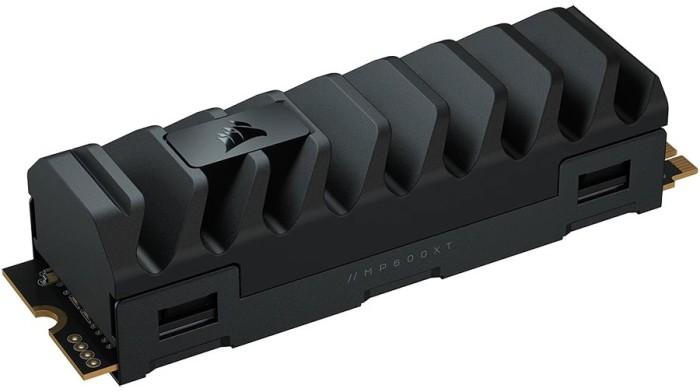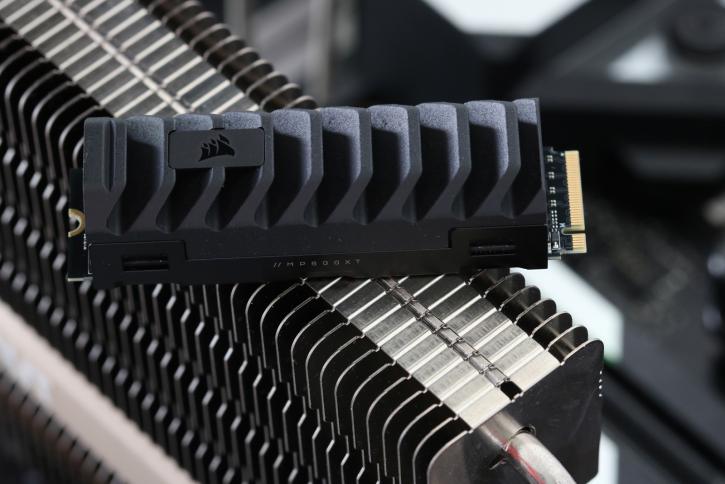Introduction
Corsair MP600 Pro XT | PCIe 4.0 NVMe SSD
Danger Will Robinson: we're breaching 7100 MB/sec
We take a look at a new revision. The Corsair MP600 PCIe Gen 4.0 SSD in the PRO XT model located under SKU code CSSD-F2000GBMP600PXT, and it is one of the best-performing NVMe SSDs we have tested to date, with performance levels passing 7 GB/sec. The 2 TB version that was tested costs 20 cents per gigabyte (GB). There is a twist in this round, though, as the storage unit is based on TLC NAND technology (this round from Micron). More to the point, Corsair has announced the availability of numerous new solid-state drive (SSD) devices. This series provides high-speed performance in the 7-GB/sec range at more affordable pricing than previous generations. Yep, we're at a wild place right now in 2021, with performance figures that are all over the place and seem to mean absolutely nothing.
The new NVMe M.2 SSD has PCI-Express 4.0 (x4) connectivity, which is faster than last gen models. The capacity lineup consists of three models with differing capacities: 1TB, 2TB, and 4TB. As well as being capable of sequential reading and writing speeds of up to 7,100 megabytes per second (MB/s), as well as random reading and writing speeds of up to 6,800 megabytes per second, 3D TLC NAND also has random reading and writing capabilities of up to 1.000,000 IOPS and PCI-Express 4.0 support for high-speed versions of the technology. SSDs of the highest potential level of performance (X4) When random access is used, the processing speed is extremely high. The product is also fitted with a large heat sink, which allows for even greater optimization of cooling performance.
As a result of its integrated heatspreader, the MP600 PRO XT provides exceptional sustained performance, beating typical M.2 SSDs by a significant margin. For performance, the MP600 PRO XT provides up to 7,100 megabytes per second sequential read rates and 6,800 megabytes per second sequential write speeds. It also supports more than one million input/output operations per second, according to the manufacturer.
In addition to providing exceptional performance and long-term durability, the MP600 PRO XT is made with high-density 3D TLC NAND, which provides up to 3,000 TB Written for the tested 4TB model and 1400 TBW for the tested 2 TB model, respectively. A projected mean time between failure (MTBF) of 1.6 million hours is predicted for the product, which is covered by a five-year warranty.
The following is a quick rundown of the new SKU (product code) numbers and prices.
Known for its great performance, the Corsair MP600 series SSD is an M.2 NVMe SSD that supports the PCI-Express 4.0 interface, bringing the Corsair MP600 Pro XT series up to date. Inside, the MP600 Pro is equipped with the new eight-channel Phison E18 controller, which is paired with Micron TLC flash memory to provide a powerful combination. The mapping tables for the SSD are stored in 1 GB of storage provided by DRAM chips.
A non-volatile memory express (NVMe 1.4) capable M.2 form factor SSD, it is packed with unique Vertically stacked TLC written (3-bits per cell) NAND. In today's world, the performance numbers provided by a quality SATA3 SSD are still outstanding. However, with the more specialized NVMe SSDs, you can easily triple times two performance, resulting in some truly impressive numbers across the board. With an M.2 2280 form factor of 8cm, the item will be compatible with the vast majority of ATX motherboards that support M.2. In any case, are you interested in learning more about the fundamental performance of this product? Well, it's all listed; on to the next pages and the remainder of the review.



